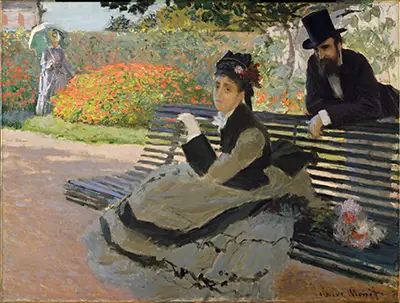The same is valid for her savvy troupe: the velvet and damask outfit nearly takes after the search for spring 1873, as publicized in the March issue of the mold periodical La Mode Illustrate. Less clear is the idea of this perplexing scene.
Painted the year Camille's dad passed away, she transmits bitterness while holding a note in her gloved hand. The top-hatted honorable man, later distinguished as a neighbor, has maybe called to offer his sympathies and a supporting bunch. Claude would also later capture Camille Monet on her Deathbed in another touching tribute.
When I first spotted this painting, Camille Monet on a garden bench, my eye is moved consequently to the back of the seat where the man is hanging over. I trust this is a direct result of the dark shading garments he is wearing. The dark gets my attention first before whatever else and after that draws my eye down towards the lady on the seat with the sad face.
At first look at this oil on canvas painting, I see the brush strokes in the ladies' dress and the seat she is perched on. It doesn't look as though Claude Monet stressed excessively over ensuring everything was mixed, maybe because he wanted to rapidly catch that minute and the picture of his significant other sitting on a seat in the recreation center before it was no more.
This sketch looks as though the hues were laid upon each other, mostly fabricating "layers." What's more, in spite of the fact that Monet and his better half appear to be in the shadow of a tree, the lighting over the shrubs indeed influences the orange-hued blossoms to emerge more. This persuades it was painted amid the Impressionism period since he painted what he felt.
The lighting reflection on the lady in the back close to the hedges influences me to feel as though she is more seasoned. It likewise drives me to think that she looks to be tuning in on Monet and his significant other potentially.
The three figures in a garden, the two women can be seen. The other woman can be identified as Camille, Mont wife who also doubled as the painter’s favorite model. She turns towards the audience with slightly large and dark eyes.
Besides the lady lies a bouquet of flower probably brought by Monet as he was known as a perfect gentleman.
Taking a look at the flat brush indicates that the wife was holding a letter in her white-gloved hand. According to sources, it suggests that the message may be a piece of condolences as Monet indicated on 23 September 1873 that a bit of bad news awaited his wife, probably the death of his father.
Impressionism developed in France amidst the nineteenth century and Claude Monet is one of the pioneers of this progressive craft development. Claude Monet has painted a portion of the best magnum opuses of Impressionism, and his works have been worshipped by faultfinders and individuals alike. Camille Monet on a garden bench is just one of the many famous paintings drawn by Monet.


